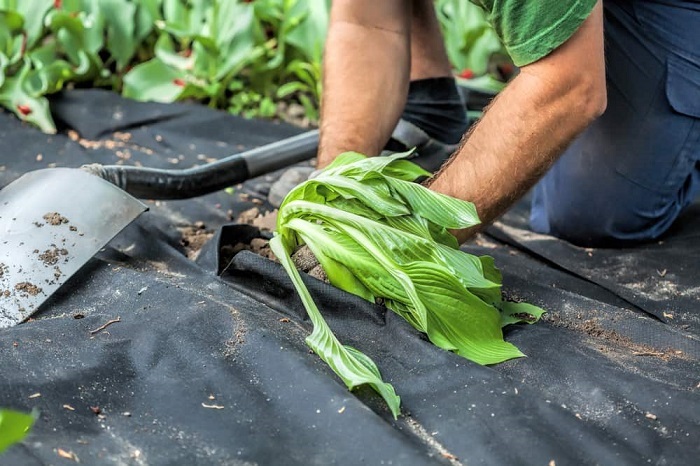
In every garden, weeds are an ugly nuisance. Consider erecting a weed barrier to keep these troublesome plants away. Weed barrier, often known as landscape fabric, is a garden fabric consisting of woven or nonwoven polypropylene. The most popular type is woven barriers, which have a strong mesh structure that keeps weeds out while enabling water, fertilizer, and oxygen to soak through and nurture your plants.
Weed barrier solutions that work well might save you hours of weeding time in your food and decorative gardens. They're efficient, dependable, and long-lasting, allowing you to spend less time removing weeds and more time enjoying your lush outdoor environment.
Weed barriers are one of the most often used non-chemical ways of preventing weeds. They're a low-cost solution to keep weeds at bay while also improving the appearance of your garden and, in vegetable gardens, increasing production by decreasing soil competition.
A good pick will be effective and long-lasting, and it will be designed to keep weeds at bay for several years. Consider the quality, durability, size, and eco-friendliness of weed barriers while looking for the best weed barrier for your garden.
Weaved and nonwoven weed barriers are available. Polyester or Polypropylene are the most common materials used in weed barriers.
Nonwoven weed barriers are a less permeable alternative that is great for weed management over time. They're less common for garden beds since they're not inherently breathable or absorbent. Instead, they're excellent for locations where no plants should grow, such as walkways and rock or gravel landscaping. The most popular nonwoven barrier materials are polypropylene and polyester.
Woven barriers, as the name implies, are composed of woven materials in a mesh-like weave. Weed barriers made of woven fabric restrict sunlight, limiting weed development. They are great for garden beds because they feature tiny holes that enable air and water to permeate the soil for plant development, unlike nonwoven alternatives.
Perforated weed barriers are similar to woven weed barriers, except that instead of a weave, they feature microscopic pinprick holes that enable water and air to pass through. The most popular materials for woven barriers are polypropylene and burlap.
A good weed barrier should last at least five years and up to twenty years or more. The finest weed barrier choices are designed to withstand wear and tear and wet and sunny weather. This prevents them from tearing readily underfoot and from breaking down after a season of rain or exposure to bright sunshine.
Weed barriers are available in various materials and thicknesses, which both contribute to their resilience and longevity. The longer the barrier lasts, the thicker and more robust the material is. Woven fabrics, such as woven polypropylene, burlap, and linen, for example, degrade more quickly than wide, nonwoven polypropylene, which might take decades to lessen.
Make sure to think about the right thickness for the project. A thick barrier, for example, is a lasting choice for a gravel pathway, but it may be too wide for a vegetable or flower garden. In the latter case, a thinner, more permeable weed barrier, even though it is less lasting, maybe a preferable choice.
The majority of weed barriers come in easy-to-transport and-use rolls. The fabric size of a weed barrier roll should be visible, so you can determine how much ground it can cover. For regions that require many pieces of weed barrier fabric, be sure to allow for an 8-inch overlap.
Weed barrier rolls are usually 3 to 6 feet wide and range in length from 50 to 200 feet. Consider a wider roll for broad covering areas to cover regions quickly.
A thicker and heavier roll tends to indicate thicker and longer-lasting cloth when comparing similar-sized barriers. Professional-grade items are more expensive than most residential products, but they can provide additional benefits such as more durable materials or higher UV protection.
The most popular weed barriers on the market are polypropylene and polyester, which are not exceptionally eco-friendly materials. Natural fibre barriers, such as burlap or linen, are more environmentally friendly than plastic barriers since they decompose faster. Regardless of the material, you may decrease your environmental impact by selecting a long-lasting choice, utilizing the wall for as long as feasible, and properly disposing of it.
Consider natural barriers such as mulch, straw, peat moss, or other organic materials for the most environmentally friendly alternative. Natural barriers demand more effort, but they are the most environmentally friendly alternative because they are biodegradable.
UV radiation is the enemy of any outdoor cloth, and all exposed weed barriers will ultimately deteriorate. A weed barrier can have several properties that help it withstand UV harm.
While some high-quality weed barriers are not UV resistant, they are nevertheless composed of long-lasting materials that may last up to 5 years in a garden. Consider topping the weed barrier with mulch, gravel, pebbles, or other organic covers to increase UV resistance. This helps the barrier remain longer by reducing its exposure to UV radiation.
There are two options when it comes to UV resistance. Some materials are naturally UV resistant and are thus designated as such. Others are UV stabilized, meaning they've been treated with a UV barrier, making them more resistant to UV damage.
The installation of a weed barrier is quite simple. To begin, measure the area where you plan to lay the weed barrier to determine the number of rolls you'll need—it never hurts to buy a few extra rolls, as with most home tasks.
Choose a weed barrier appropriate for the application; for example, a thicker, impermeable barrier for under paths vs a thinner, permeable barrier for a garden bed. After you've acquired your weed barrier, you'll need to be ready to install it.
Follow these procedures to prepare the area and install the weed barrier:
 Call Now
Call Now